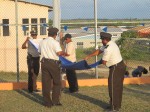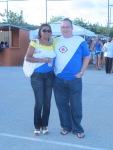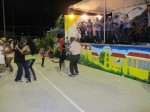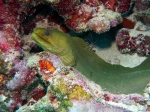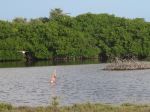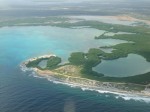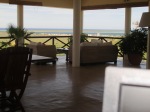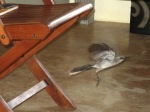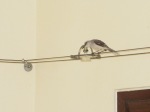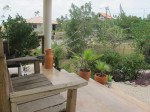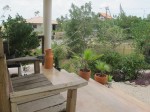The Washington Slagbaai National Park is huge. It takes up one third of Bonaire’s surface. It covers the beautiful mountainous northern part of the island. When you talk about unspo iled, this is it.
iled, this is it.
Funny how your baseline on distance shifts when you live on a small island. Since it’s more than half an hour’s drive, which is as far as it gets on Bonaire, I don’t go there very often. But when friends want to see the park, I have an incentive to go. The last time was in March.
With four in the car, we drive to Rincon and get on the sealed road to the park. I prefer to walk the park by car. It is much less of an effort and at the nice spots you can always get out and walk a bit. Past the entrance the bumpy dirt road begins, so we slow down and have time to enjoy the scenery. The land is littered with candle cacti, some of them almost 30 feet (10 meters) tall.
Our first stop is the saliña (salt pan) Mathijs. The rainy season just ended, so there still is water in this saliña. Most of the year this pan is dry, but when there is water, there are Flamingo’s. Always a winner if you want to impress Dutch friends. Especially when, like now, there are almost a hundred of these pink birds.
Once the visitors from Holland are appropriately impressed, we continue t he trip toward Playa Chikitu, where we can see the only sand dunes of Bonaire. We walk the idyllic beach and look at the waves storming toward the inlet. Treacherous currents can pull unknowing swimmers toward the sea. An exquisite place to get rid of someone you don’t like. I am in a mellow mood and tell my friends not to swim here.
he trip toward Playa Chikitu, where we can see the only sand dunes of Bonaire. We walk the idyllic beach and look at the waves storming toward the inlet. Treacherous currents can pull unknowing swimmers toward the sea. An exquisite place to get rid of someone you don’t like. I am in a mellow mood and tell my friends not to swim here.
A bit further down we are road blocked. I know there are plenty of goats in the park, and half wild pigs, but I thought cattle were a thing of the past. Now a big bull is blocking our way, and he does not seem inclined to let us pass. He is protecting his wife a bit further away. With two ladies in the car, it is up to the men to move the massive bull. With tight  buttocks, I slowly get out of the car, but it is Eric who is the real hero. He just passes the bull with his camera and takes pictures of the cow. Realizing he is fighting a lost cause, the bull turns away from the road. When it is behind a bush I dare to take a picture of him. The admiring ladies safely stay inside the car.
buttocks, I slowly get out of the car, but it is Eric who is the real hero. He just passes the bull with his camera and takes pictures of the cow. Realizing he is fighting a lost cause, the bull turns away from the road. When it is behind a bush I dare to take a picture of him. The admiring ladies safely stay inside the car.
One of the most impressive cliffs on Bonaire is the eastern side of Seru Grandi (big hill) in the park. It rises vertically up to the middle terrace of the limestone hill that was formed some 400,000 years ago. A ridge about 2/3rds up shows us where the waves have eroded the limestone for a long time. The lower terrace takes us to the sea, where high waves are pounding the shoreline. There is a blowhole here that always fascinates me. Every seventh wave you can see a rainbow in the spray that blows out of the hole.
 The most important stop is Boka Kokolishi: this is where we have lunch! My friends have a nice picnic prepared so we carry the cooler boxes to the beach of this gorgeous inlet. Tasty sandwiches and Polar beer, why don’t I do this more often? Besides a good place for the pleasant lunch, this Boka Kokolishi also is one of the most beautiful inlets of Bonaire. A so called lithothamnium bench breaks the waves half way the boka. Calcareous algae and worm shells lay an impenetrable layer in th
The most important stop is Boka Kokolishi: this is where we have lunch! My friends have a nice picnic prepared so we carry the cooler boxes to the beach of this gorgeous inlet. Tasty sandwiches and Polar beer, why don’t I do this more often? Besides a good place for the pleasant lunch, this Boka Kokolishi also is one of the most beautiful inlets of Bonaire. A so called lithothamnium bench breaks the waves half way the boka. Calcareous algae and worm shells lay an impenetrable layer in th e limestone, preventing it to erode in the breaking waves. On the landward side the calm lagoon gets overfilled with every wave and between the waves the water falls back to the sea. A place to stop and stare for hours, which we do. When I awake from my trance we have to hurry to the exit and skip the other attractive places on the road. No worries, for me there will be a next time.
e limestone, preventing it to erode in the breaking waves. On the landward side the calm lagoon gets overfilled with every wave and between the waves the water falls back to the sea. A place to stop and stare for hours, which we do. When I awake from my trance we have to hurry to the exit and skip the other attractive places on the road. No worries, for me there will be a next time.



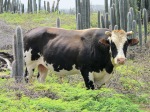



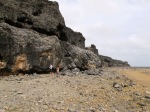





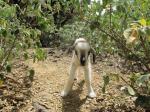




























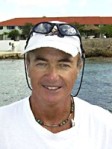






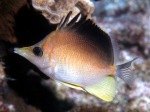






 re.
re.
